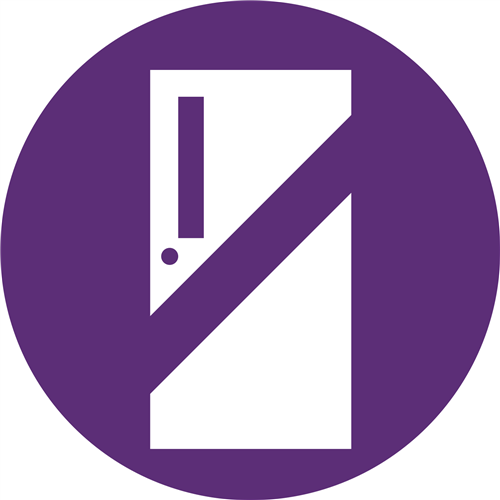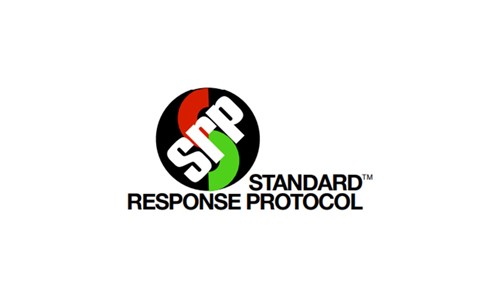Standard Response Protocol
Safety is Our Priority - Standard Response Protocol (SRP)
To ensure the entire Huntsville ISD Community is speaking the same language in terms of Safety and Emergency situations, the Standard Response Protocol will be followed by all staff, students, parents and visitors to our school builidings. Please familiarize yourself with the terms and appropriate responses for each situation.
Signage is located in all buildings throughout the district to help everyone know how to respond safely in each situation. When you hear a SRP command, please LISTEN and RESPOND correctly for your safety and others.
There will be drills throughout the year to continue to train and prepare using the Standard Response Protocol (SRP).
SRP Quick View In English
SRP Quick View in Spanish
Know What To Do! Safety Terms - Click On Each Term To Learn How To Respond.

Hold
Called when a situation requires that students remain in their classrooms or in another area, in order to keep hallways clear and away from an incident or situation.
Action:
When hallways need to be cleared; subsequent bells and any/all scheduled class changes are disregarded. Movement throughout building is stopped until all-clear is given.
Public Address:
“Hold in your classroom” and is repeated twice each time the public address is performed. Be aware if there is a need to add additional directives to any students that are not in a classroom, at lunch or some other location where they should remain until the hold is lifted. For example: “Hold in your classroom! Clear the hallways! Hold in your classroom. Clear the Hallways!”
Students are trained to remain in current location until hold “all clear” is announced.
All activities continue as usual in current location to the extent possible.
Teachers/staff are trained to recover students from hallways.
Place a sign on the main entry notifying parents and other visitors that the drill is in progress and that their access if restricted until the drill is over.
Lock classroom door.
Accountability protocols should be initiated.
Designate time after the drill for teachers to debrief with students and other staff members, as well as administration.

Secure
Called when there is a threat or hazard outside of the school building. Whether it’s due to violence or criminal activity in the immediate neighborhood, or a dangerous animal in the playground, SECURE uses the security of the physical facility to act as protection.
Action:
Schools secure school buildings and grounds during incidents that pose an immediate threat of violence in the school. The primary objective is to quickly ensure all school students, staff and visitors are secured away from immediate danger.
Public Address:
“Get inside. Lock outside doors.” and is repeated twice each time the public address is performed. “Get inside. Lock outside doors. Get inside. Lock outside doors."
All students/staff should be instructed to come into/remain inside the secure school building.
To the extent possible, instruction should continue uninterrupted.
All outside access points should be locked.
No student/staff/visitor should be allowed to enter or leave the building until the area is deemed safe.
Secure duties should be predetermined, and back-ups should be in place in case of absences.
Place a sign on the main entry notifying parents and other visitors that the drill is in progress and that their access is restricted until the drill is over.
Designate time after the drill for teachers to debrief with students and other staff, as well as with administration.

Lockdown
Called when there is a threat or hazard inside of the school building. From parental custody disputes to intruders to an active shooter, Lockdown uses classroom and school security actions to protect students and staff from threat.
Action:
Schools will secure school buildings and grounds during incidents that pose a threat or hazard outside of the school building. Lockdown uses the security of the physical facility to act as protection.
Public Address:
“Lockdown! Locks, Lights, Out of Sight!” and is repeated twice each time the public address is performed. “Lockdown! Locks, Lights, Out of Sight!” Lockdown! Locks, Lights, Out of Sight!”
Areas of campus that cannot be secured should be evaluated for additional actions that allow vulnerable areas to be evacuated quickly and efficiently.
Conduct at least one lockdown drill in areas other than classrooms, such as outside or in the cafeteria to encourage fast and effective decision making.
Place a sign on the main entry notifying parents and other visitors that the drill is in progress and that their access is restricted until the drill is over.
Designate time after the drill for teachers to debrief with students and other staff, as well as with administration.
Lockdown duties should be predetermined, and back-ups should be in place in case of absences.
Pre-designate a gathering point for outside students/staff to gather at least one block away from the school during a lockdown.
Students should be taught in advance to seek nearest secure area if they are in an unsecure/common area during a drill.
All participants should sit quietly, away from view of doors and/or windows.
Do not leave secure area or re-enter building until the drill is officially concluded.

Evacuation
Called when there is a need to move students from one location to another.
Action:
Schools will quickly move students and staff to safer locations outside of the building when a fire or other event requires that they leave the building. The primary objective of an evacuation is to ensure that all staff, students, and visitors can quickly move away from the threat.
Public Address:
“Evacuate! To a location,” and is repeated twice each time the public address is performed. For example: “Evacuate to the soccer field! Evacuate to the soccer field!
Each evacuation map should be posted on the inside of the door or adjacent to the door frame for quick visual access.
Students and staff should know the primary and secondary exit routes to exit their classrooms.
Students should know the nearest exit if they are not in their classroom and to report to the first teacher/administrator they encounter.
Evacuation drills at the start of each semester should be announced to all students and staff’ subsequent drills should be unannounced.
Use of both the PA system announcement as well as actual alerts from the alarm system for evacuation drills allow students to become familiar with how both verdinos sound.
Fire/evacuation drills should be practiced at varying times/days.
Obstructed/blocked exit fire/evacuation drills should be practiced, requiring staff/students to use secondary exits when primary exits are blocked.
Off-site evacuation drills should be practiced/simulated to prepare staff and students for additional necessary procedures and loading locations.
Place a sign on the main entry notifying parents and other visitors that the drill is in progress and that their access if restricted until the drill is over.
Designate time after the drill for teachers to debrief with students and other staff members, as well as administration.

Shelter
Called when specific protective actions are needed based on a threat or hazard. Training should include response to severe weather threats and hazmat incidents.
Action:
Schools will quickly move students, staff, and visitors indoors, perhaps for an extended period of time, because it is safer inside the building than outside. For severe weather, depending on the threat level (watch vs. warning), stakeholders may be required to move to rooms without windows to a weather shelter, or to rooms that can be sealed (chemical or biological hazard).
Public Address:
The public address for shelter should include the hazard and the safety strategy. The public address is repeated twice each time the public address is performed. For example: “Shelter in Place! Move to an interior room! “Shelter in Place! Move to an interior room!
Hazzards May Include:
Tornado
Severe Weather
Wildfires
Flooding
Hazmat spill or release
Safety Strategies May Include:
Evacuate to shelter area
Seal the room
Drop, cover and hold
Get to high ground
Severe Weather:
Public announcement should include the specific hazard and the safety strategy.
Pre-determine safe areas (lowest floor level, short roof spans, interior rooms/hallways away from exterior doors and windows).
Safe areas should be marked on posted floor plan/evacuation maps throughout Buildings (s).
Practice “Duck and Cover” position: have students sit facing the walls, crouch and cover the back of the head and neck, lacing their fingers.
Place a sign on the main entry notifying parents and other visitors that the drill is in progress and that their access if restricted until the drill is over.
Designate time after the drill for teachers to debrief with students and other staff members, as well as administration.

